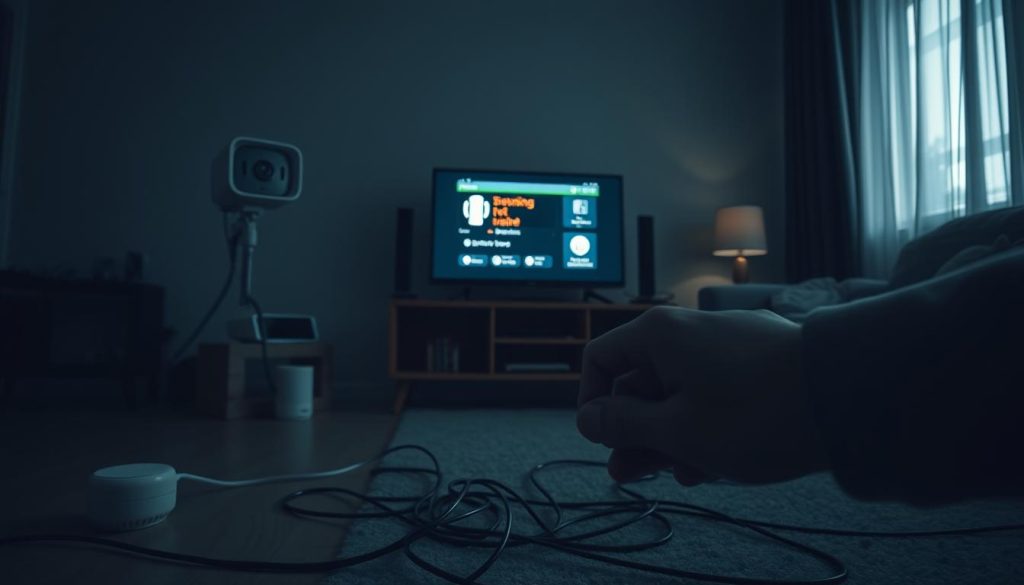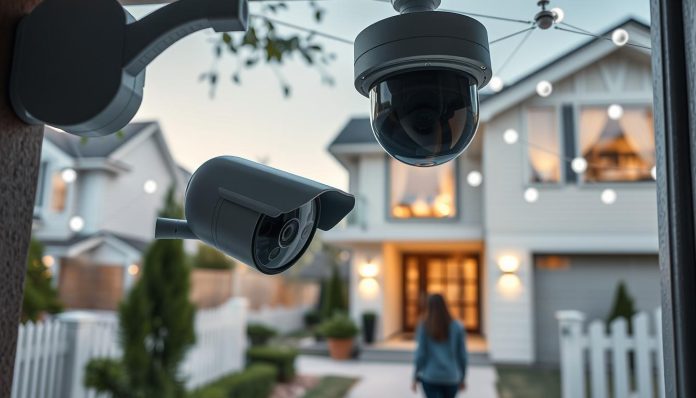Smart doorbells and cameras make life easier, but they also raise privacy concerns. Have you thought about the potential risks of facial recognition technology in these devices?
As facial recognition tech spreads, worries about privacy and security grow. The market for facial recognition is set to jump from $3.8 billion in 2020 to $8.5 billion by 2025. This shows a big rise in its use.
This growth in facial recognition tech makes us wonder about our personal data’s safety.
Key Takeaways
- The facial recognition sector is rapidly expanding.
- Smart doorbells and cameras are increasingly using facial recognition technology.
- There are growing concerns about privacy and security risks.
- The value of the facial recognition sector is expected to more than double by 2025.
- You should be aware of how your personal data is being used.
Understanding Facial Recognition Technology
Facial recognition technology is changing how we use devices and keep our info safe. It’s everywhere, from unlocking phones to making homes more secure.
What is Facial Recognition?
Facial recognition uses algorithms to identify people by their faces. It detects faces, extracts features, and checks them against a database.
This tech is used in many ways, like in security systems and unlocking phones. But, it also raises big privacy concerns because it collects and stores personal biometric data.
How Facial Recognition Works
The steps to facial recognition are:
- Face detection: Finding a face in images or videos.
- Feature extraction: Recording specific facial details.
- Comparison: Matching these details against known faces.
This tech uses advanced algorithms and machine learning. But, it also raises worries about data privacy and surveillance technology misuse.
Key Applications of Facial Recognition
Facial recognition is used in many areas, including:
- Security and surveillance: Improving public safety and monitoring.
- Personal devices: Unlocking phones and laptops.
- Social media: Auto-tagging photos and identifying people.
- Retail and customer service: Making customer experiences more personal.
These uses bring convenience and security. But, they also highlight the need to protect privacy and individual rights.
The Rise of Smart Doorbells and Cameras
The smart home industry has seen a big jump in smart doorbells and cameras. These devices are like regular doorbells but also have a camera. They let users see who was at their door up to six months ago.
More people want to keep their homes safe, leading to more brands in the market. Ring, Nest, and Arlo are well-known for their smart doorbells and cameras. They have cool features like facial recognition, motion detection, and night vision.
Popular Brands and Devices
Ring’s Video Doorbell, Nest’s Cam Indoor, and Arlo’s Video Doorbell are favorites. They’re easy to set up and work well with other smart home gadgets.
Market Trends and Consumer Adoption
The demand for smart doorbells and cameras is growing fast. In the Netherlands, 1 in 8 homes has one. This trend is expected to spread to other places, like the United States.
Advantages of Using Smart Cameras
Smart cameras bring better security, convenience, and peace of mind. They offer real-time notifications and remote monitoring. This means homeowners can keep an eye on their home from anywhere.
Using smart doorbells and cameras is not just about security. It’s about making life easier with technology. As these devices get better, we’ll see even more cool features.
Privacy Concerns with Facial Recognition
Facial recognition in smart doorbells and cameras is raising big privacy and security worries. People are concerned about data collection, surveillance, and unauthorized access to personal info. These are serious issues.
Data Collection and Storage Risks
Facial recognition tech collects and stores a lot of data. Companies like Clearview AI have huge databases without asking users first. This makes people wonder who sees their data and how it’s used.
- Data is often collected without explicit user consent.
- Storage practices vary widely among companies, with some having weak security measures.
- The potential for data breaches is a significant concern.
Potential for Surveillance and Monitoring
Facial recognition tech can lead to big surveillance and monitoring issues. It makes people feel like they’re always being watched. This can really limit personal freedom.
- Surveillance can be used by governments and corporations to monitor citizens and customers.
- The technology can be misused to track individuals without their knowledge.
- There’s a risk of creating a surveillance state where privacy is severely curtailed.
Unauthorized Access to Personal Information
There’s a big risk of unauthorized access to personal info with facial recognition. If the databases aren’t secure, hackers can get to sensitive data.
This not only compromises individual privacy but also poses a risk of identity theft.
- Weak passwords and outdated software can leave systems vulnerable.
- Insider threats are also a risk, where employees may misuse their access.
- Regular security audits and robust encryption are essential to mitigate these risks.
In conclusion, facial recognition tech has its benefits, but the privacy concerns are huge. It’s important for users to know these risks. Companies need to take strong steps to protect privacy and security.
Legal Framework Surrounding Facial Recognition
Facial recognition is getting more common, and a strong legal framework is needed. The laws around facial recognition are complex. They involve many different groups and interests.
Current Laws and Regulations in the U.S.
In the U.S., laws about facial recognition vary by state. At the federal level, there’s no single law for facial recognition tech.
Key legislation includes:
- The Biometric Information Privacy Act (BIPA) in Illinois, which has been used to sue companies for improper collection and use of facial biometrics.
- The California Consumer Privacy Act (CCPA), which includes provisions related to the collection and use of biometric information.
State-Level Legislation
Many states are making their own laws about facial recognition. For example, Washington state requires a warrant for law enforcement to use facial recognition tech.
| State | Legislation | Status |
|---|---|---|
| Illinois | BIPA | Enacted |
| California | CCPA | Enacted |
| Washington | Facial Recognition Law | Enacted |
Future Legal Implications
Future laws on facial recognition will likely come from the federal government. Big tech companies like IBM, Microsoft, and Amazon want stricter rules. This shows a move towards better regulation.
The European Union’s General Data Protection Regulation (GDPR) has set a precedent for stringent data protection laws, which may influence U.S. legislation.
Ethical Implications of Facial Recognition
Facial recognition technology raises many ethical concerns. These include bias, consent, and community trust. It’s important to understand these issues when using facial recognition in smart homes.
Bias and Discrimination Issues
Studies have found that facial recognition algorithms often show bias against people of color. This can cause discrimination and unfair treatment. The data used to train these algorithms greatly affects their fairness and accuracy.
Consent and User Rights
Using facial recognition without consent is a big ethical problem. You have the right to know how your facial data is used. It’s key to be informed and give consent for ethical use.
Impact on Community Trust
Facial recognition can hurt community trust, especially if used by law enforcement. The fear of mass surveillance can make people uneasy. Think about how this technology might affect your community and your relationship with local authorities.
To lessen these risks, use facial recognition technology openly and with strong protections. Make sure it respects privacy and builds trust in the community.
Security Vulnerabilities in Smart Devices
Smart devices, like doorbells and cameras, can be hacked. It’s key to know the risks and how to protect your home.
Hacking and Cybersecurity Threats
Cyber threats to smart homes are getting smarter. Hackers use software bugs or phishing to get into your network. They can then see and hear through your devices, risking your privacy.
Common hacking methods include:
- Phishing attacks to obtain login credentials
- Exploiting software vulnerabilities
- Using default or weak passwords
Data Breaches: Past Incidents
Smart home devices have faced data breaches before. For example, in 2019, a big smart doorbell maker had a major breach. This shows why strong security is crucial.

Best Practices for Enhancing Security
To make your smart devices safer, follow these tips:
- Change default passwords: Use strong, unique passwords for each device.
- Keep software up-to-date: Regularly update your device’s firmware and software.
- Use two-factor authentication: Enable 2FA to add an extra layer of security.
- Monitor device activity: Regularly check your device’s activity logs for suspicious behavior.
By following these steps, you can lower the risk of your smart devices being hacked.
Consumer Awareness and Education
Facial recognition technology is getting more common in home security. It’s important to learn about its privacy issues. Knowing how it works and how to keep your info safe is key in today’s smart homes.
Understanding Product Privacy Policies
Before buying a smart doorbell or camera, read the privacy policy. Find out how your data is used, stored, and shared. Be aware of any potential risks like data breaches or unauthorized access.
Importance of Transparency
Transparency is crucial with facial recognition tech. Makers should clearly explain how they use your facial data. Look for brands that provide detailed information about their data handling and give you control over your data.
Tips for Safer Smart Device Usage
To keep your privacy safe, follow these tips:
- Regularly update your device’s software and firmware to ensure you have the latest security patches.
- Use strong, unique passwords for your devices and accounts.
- Configure your device’s privacy settings to limit data sharing and collection.
- Be cautious when granting access to third-party apps and services.
| Best Practices | Benefits |
|---|---|
| Regular Software Updates | Protects against known vulnerabilities |
| Strong Passwords | Prevents unauthorized access |
| Limiting Data Sharing | Reduces risk of data breaches |
By staying informed and taking steps to protect yourself, you can enjoy smart home devices safely. Be careful and choose wisely when adding tech to your home.
Technical Limitations of Facial Recognition
Facial recognition tech is getting more common in smart homes. But, it has its limits, like accuracy and how it works in different settings. Knowing these can help you understand how well these cameras work.
Accuracy and Reliability Concerns
Facial recognition tech’s main issue is how well it works. Things like light, face angle, and camera quality matter a lot. For example, bad lighting can mess up who it thinks you are, causing false alarms or not recognizing you.
Reliability is also a big worry. The tech might not work the same way every time. This can make people doubt its ability to keep them safe.
Challenges in Diverse Environments
Facial recognition tech has a hard time in different places. Things like skin color, face shape, and how people look can mess with its accuracy. Also, things like hats, glasses, or masks can make it harder to tell who’s who.

In places with lots of differences, the tech needs to be really good. But, it often can’t handle these differences well. This can lead to wrong identifications and privacy invasion worries.
How Weather Affects Performance
Weather can really mess with facial recognition tech in smart cameras. Rain, fog, and extreme light can all make the pictures blurry. This makes it hard for the system to know who’s who.
For instance, rain or fog can hide faces, and too much sun can make pictures too bright. Knowing these issues is key to using facial recognition tech wisely.
The Role of AI in Smart Doorbells
AI in smart doorbells is changing how we keep our homes safe. It uses facial recognition technology. This makes these devices better at watching over your home.
Integrating AI with Facial Recognition
AI lets smart doorbells recognize people at your door. This makes your home security smarter. It can tell who’s familiar and who might be a threat, alerting you.
Key benefits of AI integration include:
- Enhanced accuracy in identifying individuals
- Real-time alerts for suspicious activity
- Improved overall security through advanced surveillance technology
Advantages of AI-enhanced Features
AI in smart doorbells has many good points. It makes facial recognition better and learns from you over time. This makes your home safer and more personal.
Some notable advantages include:
- Personalized notifications based on recognized individuals
- Advanced threat detection through machine learning algorithms
- Integration with other smart home devices for a comprehensive security system
Limitations of AI in Privacy Protection
AI makes smart doorbells better, but it also worries about privacy. Storing facial data can be risky if not done right.
Key considerations for privacy include:
- Secure data storage practices to prevent unauthorized access
- Transparent data usage policies
- Compliance with privacy regulations and standards
Knowing how AI affects smart doorbells and privacy helps you choose better security for your home.
Public Opinion on Facial Recognition
People have mixed feelings about facial recognition technology. They worry about privacy, security, and how new it is. As it shows up in smart doorbells and cameras, it’s key to know what people think.

Survey Insights from Consumers
Recent surveys have shown what people think about facial recognition in smart homes. Many are scared about data security and who might see their info. For example, almost 60% are worried about their data being used the wrong way.
They also worry about how well facial recognition works. It might not always get it right, causing problems. Parents are especially concerned about their kids’ safety and privacy.
Perspectives from Privacy Advocates
Privacy groups are loud about the dangers of facial recognition. They fear it could turn our homes into a surveillance state. They say we need stronger rules to keep our privacy safe.
They also say facial recognition can be unfair, leading to wrong judgments. They want to fix these issues so the tech is fair for everyone.
Industry Opinions and Expert Insights
Experts and makers of smart doorbells and cameras see facial recognition as a plus. They say it makes homes safer and more convenient. They think the good it does is worth the risks.
They also talk about how tech is getting better. Advances in AI and machine learning are tackling some of the big concerns. They believe these improvements will make facial recognition safer and more reliable.
Balancing Convenience and Privacy
Smart home devices bring you security and ease, but they also risk your privacy. It’s important to think about the good and bad sides as you use them every day.
Weighing Benefits Against Risks
Smart doorbells and cameras with facial recognition add security. They let you watch your home from afar and alert you to odd happenings. Yet, this ease might mean giving up some privacy. Think about these points:
- The kind of data your devices gather
- How they keep this data safe
- The chance of data leaks or unauthorized access
Knowing these details helps you decide if the perks of smart home tech are worth the privacy risks.
Personal Responsibilities as Users
As a smart home user, you must protect your info. This means:
- Reading and getting the privacy policies of your devices
- Setting your devices’ privacy options to gather less data
- Keeping your devices’ software up to date for better security
By doing these things, you can keep your privacy safe while still enjoying smart home tech’s benefits.
Technology Adoption vs. Privacy Preservation
Choosing to use smart home devices is more than just getting new tech. It’s also about keeping your privacy. Here’s what to think about:
| Consideration | Technology Adoption | Privacy Preservation |
|---|---|---|
| Data Collection | Devices collect data for better function | Only gather data that’s really needed |
| Data Storage | Data is stored on cloud servers or locally | Make sure data is stored safely with strong encryption |
| User Control | Devices let you monitor and control remotely | Check and update privacy settings often |
By thinking about these points, you can make choices that balance your need for convenience with keeping your privacy safe.
Alternatives to Facial Recognition
When thinking about facial recognition technology, it’s key to look at other ways to keep your home safe. Facial recognition is common in smart security cameras, but there are other options. These alternatives can help protect your privacy.

Other Identification Methods
There are many ways to identify people instead of facial recognition. Some include:
- Password or PIN authentication
- Fingerprint recognition
- Smart card or key fob authentication
- Motion detection with alerts
These methods can keep your home secure without using facial recognition.
Pros and Cons of Conventional Security Measures
For years, locks and alarms have kept homes safe. They have many benefits:
- They’ve been proven to work well
- They don’t use intrusive tech
- They’re often cheaper than smart systems
But, they also have some downsides:
- They need to be manually operated
- They can be prone to human mistakes
- They might not be as convenient as smart systems
Innovative Solutions in Home Security
New tech is always coming out to improve home security. Some new ideas include:
- Advanced motion detection with AI
- Biometric methods like voice recognition
- Smart locks that can be controlled remotely
These new technologies offer better security and might help with privacy worries about facial recognition.
Looking into these options can help you choose the best way to protect your home. You can find a balance between security, convenience, and keeping your privacy safe.
Future Trends in Facial Recognition
The future of facial recognition looks bright, especially in smart home devices. We’ll see smarter applications in smart doorbells and cameras. This is thanks to ongoing tech advancements.
Predictions for Smart Doorbell Technologies
Smart doorbells with facial recognition will become more common. They will offer better security for homeowners. These devices will likely include:
- Improved accuracy in identifying individuals
- Integration with other smart home systems
- Enhanced notification systems for timely alerts
These advancements will give users more control over their home security. They’ll be able to monitor and manage who approaches their property better.
Emerging Privacy Solutions
As facial recognition grows, so does the need for privacy solutions. New trends include:
| Solution | Description | Benefits |
|---|---|---|
| Encryption | Protecting data with advanced encryption methods | Enhanced security for user data |
| Anonymization | Removing personally identifiable information | Reduced risk of privacy invasion |
| Consent Mechanisms | Implementing clear consent processes for data use | Increased transparency and user control |
These solutions aim to reduce the risks of facial biometrics. They ensure users’ privacy is protected.
The Role of Consumer Advocacy Groups
Consumer advocacy groups will be key in shaping facial recognition’s future. They will advocate for:
- Stronger privacy regulations
- Transparency in data use practices
- Accountability in case of data breaches
These groups will ensure facial recognition technology prioritizes user privacy and safety.
Best Practices for Safe Usage
To keep your home safe with smart doorbells and cameras, follow some key steps. Make sure you’re careful with how you use these devices. This helps avoid risks linked to surveillance technology.
Selecting Privacy-Focused Devices
When picking smart doorbells and cameras, choose ones that focus on data security and privacy. Look for well-known brands that share how they handle your data. Some devices have extra privacy tools like encryption and secure storage, which boost your safety.
Configuring Privacy Settings Properly
After picking a device that cares about privacy, set up its privacy settings right. Use strong passwords and two-factor authentication to keep your device safe. Also, adjust the device’s alert settings so you only get important notifications.
It’s important to check these settings often. This is because software updates can sometimes change your settings.
Regular Software and Firmware Updates
It’s crucial to keep your smart doorbell or camera’s software and firmware updated. Manufacturers often release updates to fix bugs and improve how the device works. Turn on automatic updates if you can, and check for updates yourself if you can’t.
- Enable automatic updates for your device’s software and firmware.
- Regularly check for updates if automatic updates are not available.
- Review release notes to understand the changes and improvements made in each update.
By sticking to these best practices, you can make your smart home devices much safer and more private. This ensures a safer and more secure home for you.
Conclusion: Navigating Facial Recognition Risks
When thinking about using facial recognition in smart doorbells and cameras, it’s key to understand the risks. This technology can lead to big privacy concerns. It might let others see your personal info without permission or misuse your data.
Key Considerations for Users
It’s important to know how your devices protect your privacy. Look into the privacy policies and settings of your smart devices. This helps keep your personal data safe.
Future of Smart Home Safety
Facial recognition tech is getting better, so stay updated on new info and security tips. This way, you can choose wisely between convenience and privacy concerns.
Your knowledge and effort in handling facial recognition risks are vital. They will help shape the future of safe smart homes.

